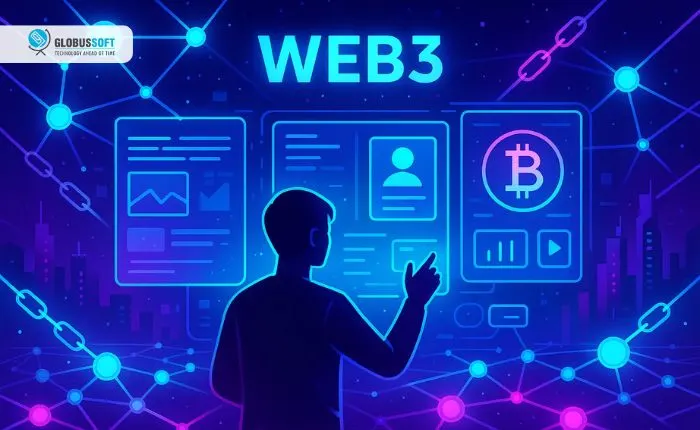
The internet has transformed our lives twice already. First, it connected us to information. Then, it connected us. Now, something new is emerging that could change everything again, web3.
Unlike previous shifts that happened gradually, this one feels different because it challenges who controls our digital lives.
Let’s explore what makes this evolution significant and why it matters to you.
Listen Podcast Now:
Web3 Made Easy: What You Actually Need to Know:
When people ask what is web3 technology, the simplest answer is: it’s the internet where users own their digital presence.
Today, when you upload photos to Instagram or create content on YouTube, those platforms technically own what you’ve shared. They control your account and data, and can change the rules at any time.
The web3 definition blockchain technology connection is straightforward. Blockchain works like a shared record book that nobody single-handedly controls.
Every transaction gets recorded permanently, and thousands of computers verify its accuracy.
This setup eliminates the need for companies like Facebook or Amazon to sit in the middle of every interaction.
Picture this scenario: You’re a photographer sharing work online. Currently, you’d use platforms that take significant commissions and own the relationship with your audience. With web3, you’d connect directly with buyers, prove ownership of your images cryptographically, and earn money without middlemen taking cuts.
To navigate this new digital landscape efficiently, creators can also leverage Useful AI Tools to manage, optimize, and enhance their work while maintaining full control over their content.
That fundamental shift from platform-owned to user-owned defines what we’re discussing.
Why This Matters Beyond Tech Circles?
Many dismiss Web3 as something only cryptocurrency enthusiasts care about.
That misses the bigger picture entirely. This technology addresses frustrations most internet users experience regularly.
- Content Portability: Web3 lets you keep access to your content across platforms, even if policies change.
- Data Control: You decide exactly what personal information to share, protecting your privacy.
- Fair Revenue: Decentralized systems return more value to creators, instead of platforms keeping most of the earnings.
These aren’t theoretical benefits. Musicians are already releasing albums directly to fans, keeping 95% of sales instead of the 15% Spotify pays.
Gamers in developing countries earn livable wages through play-to-earn models. Communities govern themselves through voting systems that platforms can’t override or manipulate.
The shift represents power moving from corporations to individuals. Instead of accepting whatever terms big tech dictates, users gain genuine choices about how they participate online.
Understanding the Technology Foundation:
You don’t need technical expertise to grasp the web3 stack, but knowing the basics helps you understand what’s possible. Think of it as layers working together.
The bottom layer is blockchain networks, an infrastructure that stores data across thousands of computers instead of central servers.
Above that sit protocols handling storage, identity, and communication in decentralized ways.
The middle layer contains smart contracts, which are basically automated agreements that execute when conditions are met.
The top layer includes applications and interfaces you actually interact with—wallets, marketplaces, and platforms.
As technology improves, this layer becomes increasingly user-friendly, hiding complexity just like modern websites hide the complicated code running behind them.
Each piece of the web3 stack serves specific purposes, working together to create experiences that feel similar to current apps but operate fundamentally differently underneath.
The goal is to make decentralization invisible to everyday users who just want things to work smoothly.
How to Build Smarter Strategies for Web3?
Jumping into web3 without planning rarely ends well. Whether you’re an entrepreneur, business owner, or curious individual, thinking strategically about this technology makes the difference between success and wasted resources.
Creating a web3 strategy starts with honest questions. Does decentralization solve the actual problems you’re facing?
Would your customers value owning their data or digital items? Can you deliver better experiences than centralized alternatives?
Forcing blockchain into situations where traditional solutions work fine makes no sense.
However, when transparency, ownership, or removing middlemen provides genuine advantages, Web3 becomes compelling.
Maybe you run a supply chain that needs verifiable tracking. Perhaps you’re building a creator platform where artists deserve more revenue. Those scenarios fit naturally.
Smart strategies also consider timing and user readiness. Your audience might love the concept but find cryptocurrency wallets confusing.
Starting with hybrid approaches, familiar interfaces powered by web3 behind the scenes often work better than expecting people to immediately embrace entirely new systems.
Regulatory landscapes keep changing, too. Building flexibility into your plans protects against sudden legal shifts that could impact how you operate.
Why Partnering with Globussoft Can Power Your Web3 Journey:
Navigating web3 alone feels overwhelming for most people and organizations.
The technology moves incredibly fast, terminology creates confusion, and early mistakes can prove expensive.
Finding experienced partners who’ve solved these problems before accelerates your journey significantly.
Globussoft brings exactly that expertise to the table. They don’t just build blockchain applications; they help you figure out whether Web3 makes sense for your specific situation first.
Their team asks tough questions about your goals, audience, and challenges before recommending solutions.
When web3 fits your needs, Globussoft handles the technical complexity.
They’ve built everything from NFT marketplaces to DeFi platforms to enterprise blockchain solutions.
Their experience across different industries means they understand nuances that generic developers miss.
What separates Globussoft from typical development shops is its educational approach.
They explain how your web3 stack works, train your team to maintain it, and ensure you’re not permanently dependent on external help. You gain capabilities, not just a finished product.
They also excel at integration. Most successful web3 strategies don’t mean abandoning existing systems entirely.
Globussoft helps you identify where blockchain adds value and where traditional infrastructure still makes sense, creating solutions that leverage both worlds effectively.
Their commitment extends beyond launch day. As web3 technology evolves and your needs change, Globussoft provides ongoing support and updates.
You’re getting a long-term partner invested in your success, not just a contractor checking boxes.
Seeing Web3 Transform Real Industries:
Abstract concepts become clearer through concrete examples of Web3 already making a difference today.
Independent authors frustrated with Amazon’s control are publishing books as NFTs, selling directly to readers who truly own their digital copies.
Smart contracts automatically pay authors royalties each time books resell, creating ongoing revenue streams impossible in traditional publishing.
Fashion brands combat counterfeiting through blockchain certificates tied to physical products. When you buy luxury items, you receive digital proof of authenticity that’s impossible to forge.
The secondhand market becomes safer because buyers verify legitimacy instantly.
Healthcare organizations explore patient-controlled medical records. Instead of your health information scattered across disconnected hospital systems, you’d manage everything through blockchain.
Grant temporary access to doctors, contribute data to research studies for compensation, or simply keep records private. Control shifts to patients where it belongs.
Charitable organizations use Web3 for transparent donation tracking. Contributors see exactly where their money goes, which projects it funds, and what impact it creates.
This transparency builds trust and encourages more generous giving.
These applications demonstrate web3 solving actual problems rather than creating technology for its own sake.
Also Read:
10 Best AI Agent Builders You Can Try In 2025
10 Useful AI Tools For Social Media
Being Real About the Current Hurdles:
Honest conversations about web3 must address existing challenges. Pretending everything works perfectly helps nobody make informed decisions.
Transaction speed remains problematic. Traditional systems process thousands of operations per second, while many blockchains handle considerably fewer.
For web3 reaching mainstream adoption, performance must improve substantially. Fortunately, newer technologies like layer-2 solutions are closing this gap.
User experience needs significant work. Managing private keys, understanding gas fees, and connecting wallets confuses people accustomed to simple usernames and passwords.
Until web3 applications feel as intuitive as TikTok or Gmail, adoption stays limited.
Security concerns are legitimate. While blockchain itself is secure, smart contracts sometimes contain bugs that hackers exploit.
Scams targeting newcomers happen frequently. Education and better security practices must improve alongside technology.
Environmental impact sparked valid criticism, especially around energy-intensive mining.
Newer blockchain models use dramatically less power, but public perception takes time to catch up with reality.
Regulatory uncertainty creates hesitation. Different governments take vastly different approaches to cryptocurrency and digital assets.
This patchwork makes building global applications challenging and increases compliance complexity.
These obstacles aren’t insurmountable, but they require continued work from the entire web3 community to address effectively.
Conclusion:
The internet continues evolving, and Web3 represents its next significant phase.
This isn’t about replacing everything that exists but expanding possibilities for ownership, control, and transparency online.
Real challenges around usability, speed, and regulation need solving before mainstream adoption happens.
Yet the core ideas address genuine frustrations millions of people experience with today’s internet.
Businesses exploring this space benefit from developing thoughtful web3 strategies with experienced partners like Globussoft guiding their journey.
Whether web3 delivers everything promised or finds a more modest role alongside existing infrastructure, understanding this technology means understanding where digital interaction is heading.
The future is being built now, and knowing what’s coming helps you prepare effectively.
FAQ’s:
Q1: Will Web3 replace today’s internet completely?
Ans: No. More likely, web3 coexists alongside current systems, offering alternatives for people valuing ownership and decentralization while traditional platforms continue serving users happy with existing models.
Q2: Is Web3 only useful for cryptocurrency trading?
Ans: Definitely not. While crypto gets the most attention, web3 enables improvements in identity management, supply chains, healthcare, voting systems, content creation, gaming, and many other areas beyond financial speculation.
Q3: How soon will average people use Web3 regularly?
Ans: Widespread consumer adoption probably sits 3-5 years away, depending on how quickly usability improves and costs decrease. However, business applications and niche communities are already seeing significant web3 usage today.









